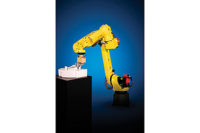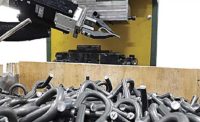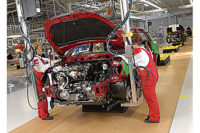What does a manufacturer do if it needs to increase production, but its robot’s range limit has been reached and space limitations prevent the addition of a second robot? For many companies, the answer is to install a robot transport unit (RTU) that brings the robot to and from where the assembly takes place.
In the spring of 2015, a German aluminum manufacturer decided to use an RTU so its six-axis robot could more quickly place various-sized steel sleeves onto reels. After each sleeve is placed, aluminum is wound around it to form a large coil that is ready for delivery.
At the time, a plant employee used a manually operated crane to lift each sleeve from a stack on a trolley and place the sleeve at a reel loading station. However, this approach was quite slow, requiring four to five minutes per sleeve.
To reduce cycle time, the manufacturer hired bsAutomatisierung (bsA) GmbH to build a custom automated system. Based in Balingen, Germany, bsA builds robotic workcells and automated systems. It also offers related engineering services (such as robot and control programming), electrical design and image processing.
Corrado Coin, sales and project planner at bsA, says the system meets two key challenges. First, it optimizes the company’s Fanuc M-2000iA robot—which weighs nearly 9 tons and handles loads of up to 1.3 tons—despite its inability to reach the loading station due to a short arm length (nearly 4 meters).
To overcome this limitation, bsA engineers use an IP 400 RA unit made by Intelligente Peripherien für Roboter (IPR) GmbH to transport the robot back and forth between the station and trolley. An added benefit of the RTU, according to Peter Jaeschke, sales manager at IPR, is it increases the work envelope of the loading station by 1,750 millimeters.
Modular in design, the 400 RA is constructed of welded steel and handles loads up to 10 tons. It is 2 meters long, but can be made longer with 100-millimeter extensions. The unit has a velocity of 1 meter per second and travels up to 80 meters. Guide rails, form-fit connections and carriages with roller guides ensure precise movement (accuracy of ±0.2 millimeter).
Challenge two is making sure that the robot’s flexible magnetic gripper safely handles and positions each steel sleeve, regardless of its size and weight (usually more than 1,000 pounds). Because the sleeves need to be placed at different heights, bsA equipped the gripper with an integrated measuring system that uses a complex algorithm to precisely detect the sleeve’s presence, position and flatness.
IPR offers ceiling-mounted, wall-mounted and floor-mounted RTUs, as well as those with coaxial extensions. All units can be programmed to stop at one or several workstations along the travel axis. They feature adjustable
elements for fast and accurate installation, and a drive system with covered tracks that can be walked on.
According to Coin, the plastic manufacturer’s automation system has operated without problems since being installed. For more information on robotic transport units, call 248-591-3880 or visit www.iprworldwide.com/en.








